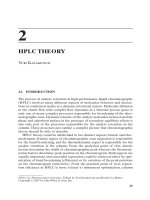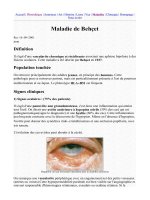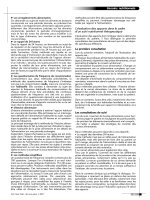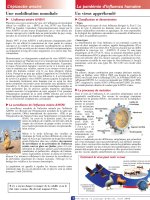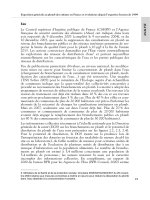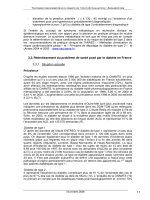Chapter 042. Gastrointestinal Bleeding (Part 2) ppt
Bạn đang xem bản rút gọn của tài liệu. Xem và tải ngay bản đầy đủ của tài liệu tại đây (79.54 KB, 5 trang )
Chapter 042. Gastrointestinal
Bleeding
(Part 2)
Peptic Ulcers
In addition to clinical features, characteristics of an ulcer at endoscopy
provide important prognostic information. One-third of patients with active
bleeding or a nonbleeding visible vessel have further bleeding that requires urgent
surgery if they are treated conservatively. These patients clearly benefit from
endoscopic therapy with bipolar electrocoagulation, heater probe, injection
therapy (e.g., absolute alcohol, 1:10,000 epinephrine), and/or clips with reductions
in bleeding, hospital stay, mortality rate, and costs. In contrast, patients with
clean-based ulcers have rates of recurrent bleeding approaching zero. If there is no
other reason for hospitalization, such patients may be discharged on the first
hospital day, following stabilization. Patients without clean-based ulcers should
usually remain in the hospital for 3 days, as most episodes of recurrent bleeding
occur within 3 days.
Randomized controlled trials document that a high-dose constant-infusion
IV proton pump inhibitor (PPI) (e.g., omeprazole 80-mg bolus and 8-mg/h
infusion), designed to sustain intragastric pH > 6 and enhance clot stability,
decreases further bleeding (but not mortality), in patients with high-risk ulcers
(active bleeding, nonbleeding visible vessel, adherent clot), even after appropriate
endoscopic therapy. Institution of therapy at presentation in all patients with UGIB
does not significantly improve outcomes such as further bleeding, transfusions, or
mortality as compared to initiating therapy only when high-risk ulcers are
identified at the time of endoscopy.
One-third of patients with a bleeding ulcer will rebleed within the next 1–2
years. Prevention of recurrent bleeding focuses on the three main factors in ulcer
pathogenesis, H. pylori, NSAIDs, and acid. Eradication of H. pylori in patients
with bleeding ulcers decreases rates of rebleeding to <5%. If a bleeding ulcer
develops in a patient taking NSAIDs, the NSAIDs should be discontinued, if
possible. If NSAIDs must be continued, initial treatment should be with a PPI.
Long-term preventive strategies to decrease NSAID-associated ulcers include use
of a cyclooxygenase 2 (COX-2) selective inhibitor (coxib) or addition of GI co-
therapy to a traditional NSAID. PPIs and misoprostol are effective co-therapies,
but PPIs are more commonly used due to less frequent dosing (once daily) and
fewer side effects (e.g., diarrhea). However, either PPI co-therapy alone or use of
a coxib alone is associated with an annual rebleeding rate of ~10% in high-risk
patients (i.e., a recent bleeding ulcer). Combination of a coxib and PPI provides a
further significant decrease in ulcers and recurrent bleeding and should be
employed in very high-risk patients. Patients with bleeding ulcers unrelated to H.
pylori or NSAIDs should remain on full-dose antisecretory therapy indefinitely.
Peptic ulcers are discussed in Chap. 287.
Mallory-Weiss Tears
The classic history is vomiting, retching, or coughing preceding
hematemesis, especially in an alcoholic patient. Bleeding from these tears, which
are usually on the gastric side of the gastroesophageal junction, stops
spontaneously in 80–90% of patients and recurs in only 0–7%. Endoscopic
therapy is indicated for actively bleeding Mallory-Weiss tears. Angiographic
therapy with embolization and operative therapy with oversewing of the tear are
rarely required. Mallory-Weiss tears are discussed in Chap. 286.
Esophageal Varices
Patients with variceal hemorrhage have poorer outcomes than patients with
other sources of UGIB. Endoscopic therapy for acute bleeding and repeated
sessions of endoscopic therapy to eradicate esophageal varices significantly
reduce rebleeding and mortality. Ligation is the endoscopic therapy of choice for
esophageal varices because it has less rebleeding, a lower mortality rate, fewer
local complications, and requires fewer treatment sessions to achieve variceal
eradication than sclerotherapy.
Octreotide (50-µg bolus and 50-µg/h IV infusion for 2–5 days) further
helps in the control of acute bleeding when used in combination with endoscopic
therapy. Other vasoactive agents such as somatostatin and terlipressin, available
outside the United States, are also effective. Antibiotic therapy (e.g., quinolones)
is also recommended for patients with cirrhosis presenting with UGIB, as
antibiotics decrease bacterial infections and mortality in this population. Over the
long term, treatment with nonselective beta blockers decreases recurrent bleeding
from esophageal varices. Chronic therapy with beta blockers plus endoscopic
ligation is recommended for prevention of recurrent esophageal variceal bleeding.
In patients who have persistent or recurrent bleeding despite endoscopic
and medical therapy, more invasive therapy is warranted. Transjugular
intrahepatic portosystemic shunt (TIPS) decreases rebleeding more effectively
than endoscopic therapy, although hepatic encephalopathy is more common and
the mortality rates are comparable. Most patients with TIPS have shunt stenosis
within 1–2 years and require reintervention to maintain shunt patency, although
the use of coated stents appears to markedly decrease shunt dysfunction, at least in
the first year. A randomized comparison of TIPS and distal splenorenal shunt in
Child-Pugh class A or B cirrhotic patients with refractory variceal bleeding
revealed no significant difference in rebleeding, encephalopathy, or survival, but a
much higher rate of reintervention with TIPS (82% vs. 11%). Therefore, TIPS is
most appropriate in patients with more severe liver disease and those in whom
transplant is anticipated. Patients with milder, well-compensated cirrhosis should
require fewer re-interventions with decompressive surgery, although the higher
initial risks of surgery must also be considered.
Portal hypertension is also responsible for bleeding from gastric varices,
varices in the small and large intestine, and portal hypertensive gastropathy and
enterocolopathy.

